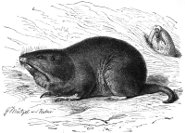 The Plains pocket gopher (Geomys bursarius) or "pocket gopher" inhabits the sandy soils of Texas. Pocket gophers are fossorial, which means that it has adapted to the digging and life underground. They dig labyrinthic burrows that can easily extend over 100 meters using their front claws and front teeth while using their hind feet for propulsion. Their tunnel construction rate is around 20 meters maximum and a pocket gopher weighing only around 150 grams can create a mound weighing hundreds of kilos (!).
The Plains pocket gopher (Geomys bursarius) or "pocket gopher" inhabits the sandy soils of Texas. Pocket gophers are fossorial, which means that it has adapted to the digging and life underground. They dig labyrinthic burrows that can easily extend over 100 meters using their front claws and front teeth while using their hind feet for propulsion. Their tunnel construction rate is around 20 meters maximum and a pocket gopher weighing only around 150 grams can create a mound weighing hundreds of kilos (!).Their burrows keep them relatively safe from predator, except for weasels and badgers. Outside of their burrows, they become prey for a variety of animals. Among their predators are long-tailed weasels, skunks, badgers, snakes, coyotes, domestic cats and raptors like hawks and owls.
While pocket gophers are seen as pests by many farmers and suburban lawn owners, they help in soil aeration and flood control (drainage).
They got their name from their external cheek pouches, which make this family unique. The cheek pouches can be turned inside-out (for grooming) and are used for carrying food up to 7 centimeters in length.
The Plains pocket gopher is listed as Least Concern (LR/lc), lowest risk. Does not qualify for a more at risk category. Widespread and abundant taxa are included in this category, on the IUCN Red List of Threatened Species
Some facts about the
Plains pocket gopher
Adult weight : 0.177 kg (0.3894 lbs)
Maximum longevity : 12 years
Female maturity :91 days
Male maturity : 91 days
Gestation : 51 days
Weaning : 34 days
Litter size : 4
Litters per year : 1
Weight at birth : 0.005 kg (0.011 lbs)
Weight at weaning : 0.023 kg (0.0506 lbs)
Basal metabolic rate : 1 W
Body mass : 0.197 kg (0.4334 lbs)

Custom Search